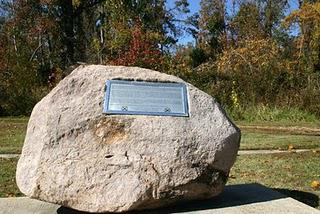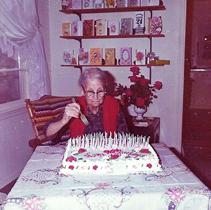Area Bloggers
Champion Tree Guards Heritage
August 15th 2011 by Unknown

It has been a sort of “keeper” of one of the most unique tracks of land in Southeast Missouri. It’s a sentinel guarding the bluff above the river.
The champion American beech tree has watched Indians paddle canoes down the river and the march of Europeans into the western half of the nation. Steamboats, paddlewheels, barges and more have floated by spot at the top of the hill – situated at a precious point looking out over the Mississippi and protecting the old St. Vincent’s Seminary in Cape Girardeau.
Now this champion beech tree guards the eastern ground of the River Campus of Southeast Missouri State University. But its roots are deep in the heritage of the region.
] Back when its was a seminary, it was a part of the young student’s tradition. The beech tree was the “Initial Tree” and young seminarians would climb the thick branches and carve their initials into the tree for posterity. Still today, you crane your neck up to the sky, and you can see their initials carved for decades in the limbs of this giant tree.
 Mark Twain wrote about the Seminary in his 1883 book, Life on the Mississippi. He writes, “There is a great Jesuit school for boys at the foot of town by the river. Uncle Mumford said it has as high a reputation for thoroughness as any similar institution in Missouri.”
Mark Twain wrote about the Seminary in his 1883 book, Life on the Mississippi. He writes, “There is a great Jesuit school for boys at the foot of town by the river. Uncle Mumford said it has as high a reputation for thoroughness as any similar institution in Missouri.” When SEMO developed the spot for the River Campus, they were wise to keep such treasures as the enormous beech. They even put wonderful benches at points near the tree, so visitors can pause, and look up at the magnificent span of branches.
I sat there the other day during a quick visit to campus and wondered –what prayers were offered by the seminarians under the shade of that beech? What devotionals were written? What scripture was studied?
And now, as the center for arts education, what music is studied under the boughs of that tree? What lines are rehearsed for a theatrical performance? A friend has told me that she is actually a little glad they didn’t have the River Campus when she was a student – she would have wanted to sit and watch the Mississippi instead of being inside practicing music!
Next to the beech tree is the Old Mississippi River Bridge Scenic Outlook, A small, restored portal of the old river bridge is all that remains today. At the overlook there is a viewing scope that provides a commanding view of the Mississippi River. You can stand at the outlook, and watch the river make its way to New Orleans and view the impressive Bill Emerson Memorial Bridge. It’s a great way to use the portal to the old bridge – keeping a bit of the old to view and appreciate the new!
Annabeth Miller is the editor of the ShowMe Times and a lifelong resident of Dexter.
Last Updated on August 15th 2011 by Unknown
https://showmetimes.com/Blogpost/ujri/Champion-Tree-Guards-Heritage
Frenchman's Spring Is Rich In Local History
August 08th 2011 by News

Our area is a crossroads of history and often-overlooked treasures. I like taking the crossroads, because you never know what might be around the next bend in the road or over the next hill.
Take, for instance, Frenchman's Spring. Located just south of Dexter about a mile west of Highway 25, the area played a significant role in the region during the War Between the States.Our area is also a crossroads of history and often-overlooked treasures.
Frenchman's Spring was a gathering spot for soldiers fighting for the Southern cause. Military units camped at the spring, and it was a place where Southern groups recruited new members. In fact, in July of 1861 more than 2,000 soldiers from 15 counties in the Show-Me State met and organized. The result of their encampment was the formation of the First Division, Missouri State Guard, a pro-Confederate state militia. The stone that stands today at Frenchman's Spring states that on July 25, 1861 the men elected M. Jeff Thompson as commander.
Meriwether Jeff Thompson was born at Harpers Ferry (the home of John Brown's infamous raid) and into a family that had a strong military tradition. He moved to Missouri in 1847 and in 1848 he moved from Liberty to St. Joseph. He worked as a store clerk, and eventually took up surveying and was the city engineer. He was mayor of St. Joe from 1857-1860 and presided over the ceremony marking the first ride of the Pony Express on April 3, 1860. Thompson had the distinction of having a ship in the Confederate Navy named for him.
Thompson commanded the First Military District, which included our "swampeast" corner of the state. The battalion soon became known as "Swamp Rats" and Thompson as the "Swamp Fox of the Confederacy." (Aren't you glad DHS is the home of the Bearcats, and not Swamp Foxes!!)
In October 1861 Thompson led a cavalry attack on the Iron Mountain Railroad bridge near Blackwell in Jefferson County. After burning the bridge, Thompson rejoined his infantry in Fredericktown. He was defeated at the Battle of Fredericktown and withdrew, leaving the Bootheel in Yankee control.
Thompson engaged in a number of battles before returning to Arkansas in 1863 to accompany Gen. Marmaduck on his raid into Missouri. Thompson was captured in August in Arkansas, and spent time in St. Louis' Gratiot Street prison. He was exchanged in 1864 for a Union general, and joined Maj. General Sterling Price's expedition into Missouri. After the war he moved to New Orleans and resumed work as an engineer, helping improve the swamps. He died in Missouri in 1876 and is buried in St. Joe.
The line of hills in which Frenchman's Spring is nestled is full of naturally flowing streams.
The pond adjacent to June & Cliff Manlove's place on South Walnut Street is fed by a natural spring on the hillside. Cliff has said that the original deed for the property dates back before the war and mentions the springs. Apparently crews on the railroad would stop near the property and would walk from the tracks to the spring and fill buckets with water and tote them back to the train for the steam engines.
You can drive to Frenchman's Spring by going south out of Dexter on Highway 25 and turn right (west) on County Road 632. Stay on the gravel road until you come a curve (north) in the road. The monument and springs are to the left on that curve.
 The monument was placed at the site in 1996 by the A.C. Riley Camp of the Sons of Confederate Veterans. I visited the site for the first time at the dedication.
The monument was placed at the site in 1996 by the A.C. Riley Camp of the Sons of Confederate Veterans. I visited the site for the first time at the dedication.I visited the spring just Saturday as part of a geo-caching day with a friend. I actually found my first cache at the spring!
There are two rock homes near the spring and folks live down there. I have been there when it was a cat-lover's paradise!! They roamed around the area like they owned the place, drank from the spring (that still flows), and enjoyed sunning themselves in the "sun puddles."
Annabeth Miller is the editor of the ShowMe Times and a lifelong resident of Dexter.
Last Updated on August 08th 2011 by News
https://showmetimes.com/Blogpost/ujof/Frenchmans-Spring-Is-Rich-In-Local-History
The Little Things To Remember
July 11th 2011 by News

It was one of those defining moments that just kind of slap you in the face like a bucket of ice-cold water!
I knew there were times when words would come out of my mouth that sounded just like my mother, and there are things I do around my house or with my plants that are exactly the way she would do them. I guess most women have that sort of thing happen -- you know, like the way you peel an apple or stir a pot of soup. I have also been known I hold my tongue just so when I am concentrating on a specific task -- something my brother says is exactly like our mom. He also says I work in the kitchen just like her - which is scary because she used to drive me crazy when we would work in the kitchen together!
But I think I also inherited a lot from my Grandma Miller.
Grandma was a feisty woman.
Born down the road in the little Dunklin County community of Caruth in the later days of Reconstruction, Elizabeth Bell Jones Trotter Miller was one tough cookie. She was one of the first women to graduate from the Normal College (now Southeast Missouri State University) in Cape Girardeau, she taught in little country schools in the Bootheel, and stuck to some very strongly held principals.
Reading and improving your mind were of the utmost importance -- a passion she passed to her children and her grandchildren. In fact, all three of her granddaughters -- cousins Pat in St. Louis, Susan in New York City and me -- have centered their careers in one form or another on the written word. You always remembered to go to church, you read your Bible, you did your patriotic duty and voted each election day and you didn't turn your back on those in need.
My dad used to tell the story of how the people in church one time literally turned their back on a young widow and her children. The “powers that be” apparently did not like something this young widow had done. So they kicked her out of church and literally turned their backs as she walked her young children out. Not my grandmother. Dad told the story that standing in church that day his mom kept saying quietly over and over "we will not turn our backs, we will not turn our backs." And she didn't - she helped that young woman, took some chickens over to their farm and included her in the little quilting group.
During my high school years, I had a paper route. Every day after school, I would head to the office, get my stack of papers, and head out. I had the "store route" -- delivered papers to Myer's Rexall and across the street to Archie Parker's drug store, dropped off a copy to Seed Bland at City Hall, and put the papers in at Big Star, Shipman's Market and all the other racks in town.
My last stop of the day was always at Grandma's. Some days she would ask me to bring her a treat on my next trip -- usually a "Snickers without the peanuts". Translation: A Milky Way. The next day when I was in Shipman's I would ask Mrs. Shipman to point out the freshest candy bars, and she would help me pick out the best one for Grandma. Now, it was really a sight to see a 95-year-old woman get excited over a little ol' candy bar. But Grandma sure did!
But wait: She just didn't tear into the wrapper and gobble up the chocolate creation. Oh, no. She would carefully take out a petite paring knife and slice off a thin, little quarter-inch sliver of the chocolate bar -- just enough "to satisfy the sweet tooth." Then she would neatly pull the wrapper back over and secure it closed with a red rubber band. She would snack on that one "Snickers without the peanuts" for several days, each time carefully slicing off just a bit and then rewrapping the bar.
I enjoy an occasional "Snicker without the peanuts" these days. So when I unwrap that little candy bar I think of my skinny little granny with all the spunk.
It is interesting how little things like a candy bar or peeling an apple can keep those we love in our hearts long after they have gone.
My mom and I always collected old wheat-back pennies. We kept our collection in a little pot I made in 8th grade art class, and I still look at the flip side of a penny to see if it could join the collection.
There have been times in the last few years when I have found a wheat-back at just the right times. It has always seemed to me as though they are my Mom's signal that everything will be okay -- that everything will work out for the best.
Whether it's a chocolate bar or a wheatback penny, those we love are always with us. I guess it is left up to us to be open to those occasions - and then take a deep breath to remember the love.
Annabeth Miller is the editor of the ShowMe Times and a lifelong resident of Dexter.
Last Updated on July 11th 2011 by News
https://showmetimes.com/Blogpost/uj8d/The-Little-Things-To-Remember
The 'Glorious 4th of July'
July 03rd 2011 by Unknown

Family legend has it that the young lad had saved all his hard-earned summer money -- probably earned while sweating through some lawn-mowing jobs and working in a hot pressroom. Proud as a peacock, he went to the fireworks stand, and purchased the biggest pack of firecrackers to be had -- Black Cat. This was the early 1960s, and pack of Black Cat was a big thing then. It was the Cadillac of firecrackers.
On the morning of Independence Day the flag was placed outside the home, and mom was in the kitchen fixing a blackberry cobbler. But my knotheaded brothers were out on the front steps, anxiously awaiting the moment when they could let those Black Cats go. A punk (not a teenager with an attitude, but a lighting device!) was in hand. But wait! Maybe it wasn't burning. So proud John laid down the “bad” punk and ran back into the house to light a second punk at the kitchen range.
While he was standing there, backup punk in hand, his pack of Black Cats was on the front step. He suddenly blanched and was the shade of a boll of cotton when there was an explosion of sound coming from the front yard. It sounded like Sherman and all his Army was thundering through the neighborhood. But it wasn't Sherman. the neighbors, or even the precious little sister.
No indeed, it was the pack of highly-treasured Black Cat firecrackers, lit by the punk that "wasn't burning.".
The entire Independence Day Celebration went up in less than a minute in a decibel-breaking racket and a puff of smoke. John didn’t even have time to hustle from the kitchen to the front porch to see the puff of smoke.
The 4th of July was always big stuff around our house. Not only did we attempt to celebration our nation's birthday in style, it was also the oldest knotheaded brother's birthday. He never has quite figured out that the fireworks are not in his honor.
But the 4th would be a day of shooting a few firecrackers, lighting a few other whirligigs, and waiting anxiously for the evening. Aunt Dorothy and Uncle Dick (Trotter) would come over, a freezer of ice cream would be ready, and mom would carry out the best-tasting blackberry cobbler this side of the Ozark hills. Finally, when the sun would set quietly in the west, the fireworks would come out. Little sis didn't get to do too many -- maybe the waterfall off the clothesline, a pretty fountain cone, and, of course, sparklers. There had to be sparklers.
All of these sorts of celebrations are appropriate for our nation's birthday. History tells us that John Adams -- one of the men who brought this nation into existence -- actually wanted Americans to celebrate Independence Day in a grand manner.
In a letter to wife Abigail, Adams wrote that the day should be a "great anniversary festival. It ought to be commemorated as the day of deliverance, by solemn acts of devotion to God Almighty. It ought to be solemnized with pomp and parade, with shows, games, sports, guns, bells, bonfires, and illuminations, from one end of this continent to the other, from this time forward forevermore."
In a strange quirk of history, Adams and colleague Thomas Jefferson were to think of one another 50 years after the fateful signing of that Declaration of Independence. Both on their deathbeds, thoughts turned to the other and to the nation they helped establish. At Monticello, Jefferson stirred, and asked if it was the Fourth. Hearing a yes, historians say he lay quietly back down. Occasionally, his hand could be seen moving, as if he were writing, this mimicking the motions of penning that important document.
North in Massachusetts, John Adams' awoke in the morning and said "It is the glorious 4th of July. God bless it, and God bless you all." Sometime in the afternoon, he roused again, and said his final words: "Thomas Jefferson survives."
Two men, close friends and so important in the birth of our freedoms, died on the same day -- 50 years to the day after they signed the Declaration of Independence.
America will have celebrations this weekend from Alaska to Missouri to New Hampshire. Politicians will pontificate and attempt to lift up the heritage left to us by such men as Adams and Jefferson.
But to me, the 4th of July is in the backyard celebrations. It's in the light on a kid's face as they twirl around with a sparkler in the early evening. It's the voices of youngsters standing on the Dexter post office steps reciting the Pledge of Allegiance, it's the fireworks overhead, and sharing the oo's and ah's with friends. It's in blackberry cobbler and homemade ice cream and reading the Declaration of Independence just one more time.
Happy Independence Day! Celebrate America!
Annabeth Miller is the editor of the ShowMe Times and a lifelong resident of Dexter.
Last Updated on July 03rd 2011 by Unknown
https://showmetimes.com/Blogpost/uj5l/The-Glorious-4th-of-July
Happy Birthday, Camp Latonka
June 23rd 2011 by News

It was 60 years ago this week a place that has become special to many women in Southeast Missouri and beyond first opened. Sixty years ago this week the gate at Camp Latonka opened for the first time for girls to attend summer camp.
Now the story of how Camp Latonka came to be - and the people who made it happen - could be a great book. But for now, let's just consider the unique legacy of the place that has been a magnet for many a girl for six decades.
There are two parts of the Latonka story that I think are remarkable.
The first is the incredible Latonka tradition - the important things that have stayed constant throughout these 60 years. And for that, we have people like Beaver Brown, Bid Miles and the entire Baker-Brown-Miles families, and Illena Aslin, Edna Sargeant, and Dexter residents Edith Camp and Mary Ulen, and so many, many more who instilled a priceless purpose to Latonka and valued the girls who were there.
And the second thing that I feel is great about Latonka is how it can reach to (strong) women of all generations - and the meaning and importance and memories are equally important across the years.
The hills at Latonka are, to me, priceless. It has always held a very precious spot in my heart. Just like Cotton Boll Girl Scouting, Latonka made such an important impact in my life. There was something so unique in our tradition - every girl had value, every girl could grow, every girl could reach inside and accomplish what she might not thought was possible. It didn't matter if you were from Dexter or Doniphan, Peach Orchard or Puxico, Sikeston or Kennett or Wardell. Latonka was for YOU. You could be independent, share thrills and joys of friendship, learn of God's incredible gifts in Nature, and sing - yes, oh sing - beautiful songs.
My thoughts go back to the 40th Anniversary (now 20 years ago!) and the Chapel service that weekend. I remember Marky Ford standing and talking about the memories in those hills. It's true - those hills, rocks, and trees hold our memories. I can still hear the voices and the songs. I can hear the cabin door slam in Hickory Hollow, the chitter-chatter of girls not-quite asleep in Shady Oak, laughter from the cabins in Gypsy Dell. The stories from the Level Acre unit house are still there ... ready to share that wonderful spot with new generations of CITs.The songs in the Dining Hall and at the Waterfront are still sung in my heart. And those darn rocks ... I still have a pretty good scar on a knee from a Gypsy Dell rock! Memories of friendships, of wonderful days in our lives, of bonds that tie each generation to that spot.
It's a wonderful thing to celebrate 60 years of a grand tradition and the generations of strong women who grew and learned and now share because of that tradition. So, I say Happy Birthday Camp Latonka.
And Happy Birthday to all the girls and women who made it all the best spot in the world!
P.S. How many still wash dishes in Dining Hall order?
Annabeth Miller is a resident of Dexter and the editor of the ShowMe Times, and a former camper and camp director at Girl Scout Camp Latonka. She is in the photo above.
Last Updated on June 23rd 2011 by Unknown
https://showmetimes.com/Blogpost/uj2t/Happy-Birthday-Camp-Latonka

